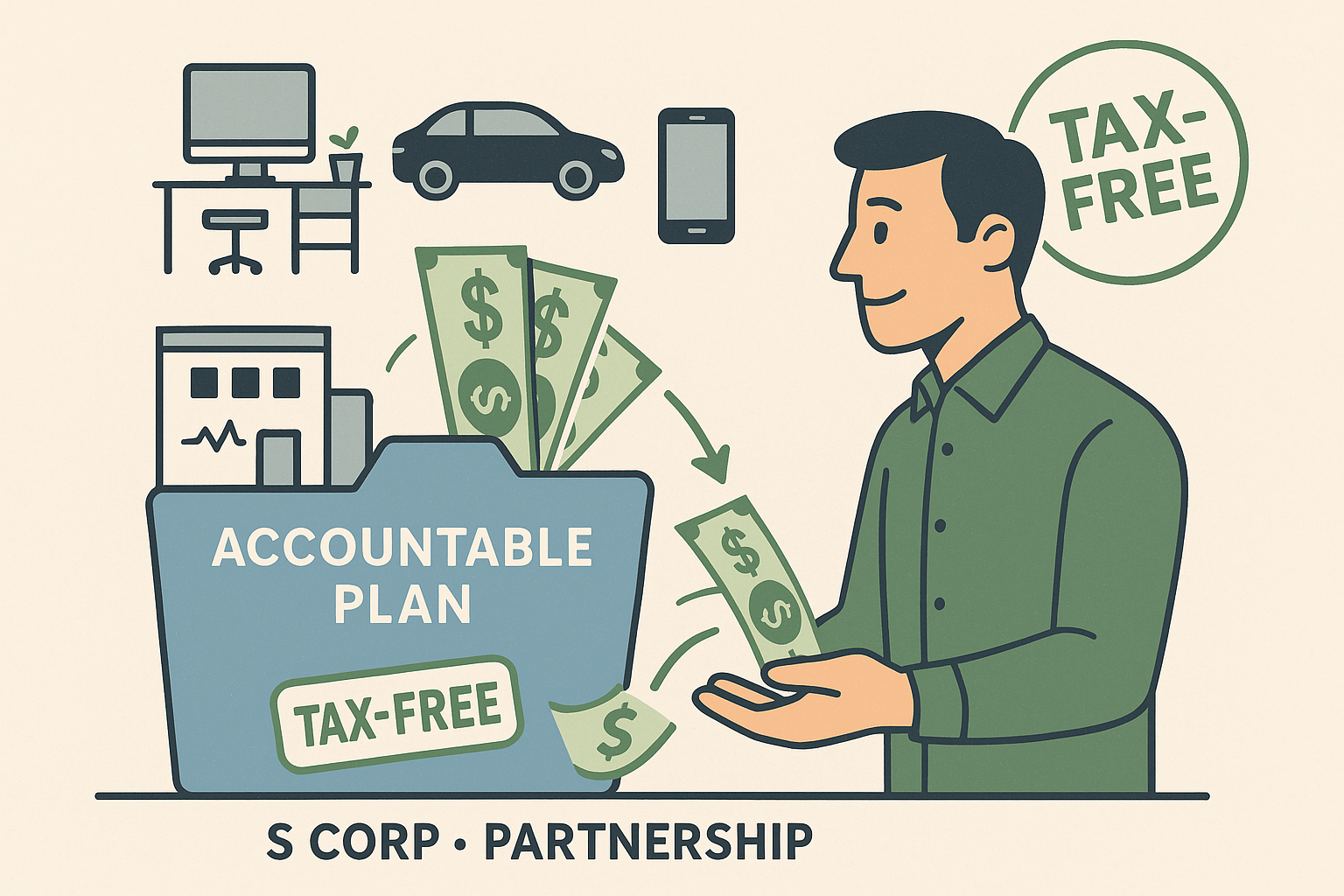Introduction
Almost no one is using retirement plans to their full potential to lower their tax. That’s a shame, because these plans are hands-down one of the most IRS-approved ways to cut your tax bill while actually keeping the money (eventually) for yourself.
In this post, I’m breaking down the real ways to use retirement plans to shrink your taxes. No gimmicks—just solid, practical advice that I’ve seen work over and over again for business owners, individuals, and freelancers.
Why Retirement Plans Are a Tax Strategy, Not Just a Savings Tool
When people think “retirement plan,” they imagine a 401(k) where their paycheck vanishes into some account they’ll touch in 30 years. But for me—and for my clients—it’s more like a tax-reduction tool with bonus retirement savings.
Every dollar you contribute to a traditional retirement plan lowers your taxable income today. That means less income for the IRS to tax. If you’re in the 32% tax bracket, every $10,000 you tuck away can save you $3,200 in taxes. That’s not nothing.
And that money grows without you owing tax on the gains until later (or never, if you play your Roth cards right). That’s the magic of tax deferral. It’s like giving your money a nitro boost—earnings compound faster without the drag of annual taxes.
It’s also not just about saving—retirement accounts can reduce self-employment tax, help keep your adjusted gross income low (which helps for other tax benefits), and they even make you look better to lenders.
So, the IRS is basically paying you to save for your future. Having well-funded retirees is good for society, and the tax code is designed to encourage that sort of behavior.
Best Retirement Plans for Individuals

Individuals who are W-2 employees often feel boxed in when it comes to tax strategy. But they’ve got some sneaky-good tools at their disposal. Here are the two best retirement plans for individuals:
401(k)
You can usually defer up to $23,000 of your income (2025 numbers) into a traditional 401(k). That’s $23K you don’t pay income tax on this year. Boom.
Got a Roth 401(k) option? Even better. You don’t get the deduction now, but all the growth and future withdrawals are tax-free. I usually tell younger or mid-career folks to split their contributions 50/50 between traditional and Roth to hedge their bets (up to the Roth limits). The best part of having both Roth and Traditional 401(k)s in retirement is that you can game distributions from each to minimize your tax rates.
Employer match? That’s literally free money. I once had a client leaving $3,000 a year on the table because he wasn’t contributing enough to unlock the match. Painful.
High-income and already phased out of direct Roth IRA contributions? You may qualify for a Backdoor Roth IRA (more on that below).
Health Savings Account (HSA)
And don’t overlook the Health Savings Account (HSA). If you’ve got a high-deductible health plan, this is the triple tax play. Deductible in, tax-free growth, and tax-free out (if used for qualified health expenses). And after age 65, you can use it for anything—just pay regular tax like an IRA.
Best Retirement Plans for Business Owners
This is where the real power lies.
If you’re self-employed—even as a side hustle—you’ve got way more flexibility. You can design your own tax strategy buffet.
SEP IRA
Start with the SEP IRA. It’s simple and lets you contribute up to 25% of your net earnings, capped at $69,000 (2025). I’ve had solopreneurs make $150K and sock away $30K with a SEP. It’s like a cheat code.
Solo 401(k)
Then there’s the Solo 401(k). This one’s my favorite for self-employed folks. It lets you do both an employee deferral and an employer match—for the same person (you). That means up to $69,000 in total contributions, even more with catch-up if you’re over 50. Plus, you can add a Roth option.
Defined Benefit Plans
Have a monster income year? Defined benefit plans allow you to save hundreds of thousands of dollars per year if set up correctly. I’ve had clients deduct over $200K in a single year using a combo of DB + 401(k). That’s not for everyone, but when it fits, it’s magic.
Just remember: your business entity affects how much you can contribute. S corps treat you like an employee, so your salary drives the limits. Sole proprietorships (Schedule Cs) use net earnings. That can change the game.
How to Layer Multiple Plans to Maximize Tax Savings
Most people think you have to choose one plan. But layering is where things get fun.
Say you’re a W-2 employee and you run a side gig. You can max your day-job 401(k) and open a Solo 401(k) for your freelance income. Totally allowed, as long as the contributions come from different income sources.
You can also pair a traditional IRA (if you qualify) with your employer plan, or do a Backdoor Roth if you don’t. Toss in an HSA and you’re up to four different accounts reducing your tax bill in some way.
Married? Double it. Spousal IRAs are legit, even if one partner isn’t working.
If you’re married, you and your spouse can run a maxed a 401(k), Solo 401(k), SEP IRA, two Roth IRAs, and two HSAs. It’ll take a spreadsheet to track, but you can defer nearly $100K in one year and build long-term tax-free wealth too.
What to Do When You Make Too Much to Contribute Directly
Alright, high earners—this section’s for you.
Let’s say your income is above $240K as a single filer. That rules out direct Roth IRA contributions and possibly deductible traditional IRAs too. But it doesn’t mean you’re stuck.

Backdoor Roth IRA
Backdoor Roth IRA is the go-to move. Here’s how it works:
- Contribute to a non-deductible traditional IRA.
- Immediately convert it to a Roth IRA.
- Pay zero tax on the conversion—if you don’t already have pre-tax IRA balances.
Got pre-tax IRA money? You’ll trigger the pro-rata rule, and the IRS will tax part of your conversion. Not ideal.
That’s where the Mega Backdoor Roth comes in. If your 401(k) allows after-tax contributions (not Roth—after-tax), you can sock away up to the full IRS limit plus roll it into a Roth. I’ve helped high-income clients squirrel away $40K+ this way, completely legally.
Worst case? Use a taxable brokerage account with tax-efficient index funds and capital gains harvesting. It’s not perfect, but better than nothing.
And don’t forget Roth conversions in lower-income years—like after selling a business or retiring early. Suppose you’re married and have a healthy Roth account when you retire at 55. You can convert $400K over five years at a 12% rate. That’s tax-free growth for life.
5 Mistakes to Avoid When Using Retirement Plans for Tax Savings
Even with all these options, people still mess this up. Here’s what I see most:
- Missing contribution deadlines. IRAs give you until Tax Day, but employer plans like Solo 401(k)s must be opened by 12/31—even if funded later.
- Over-contributing. Especially with multiple plans. The IRS doesn’t like that.
- Not coordinating with your spouse. You could be doubling efforts or missing easy wins.
- Mixing pre-tax and post-tax money in IRAs. This screws up conversions and triggers unnecessary tax.
- Thinking you have to be a millionaire to use these plans. You don’t.
I’ve had clients cost themselves thousands by forgetting about RMDs (Required Minimum Distributions) or not planning Roth conversions before they become eligible for Medicare. You’ve got to think ahead.
Conclusion
Retirement plans aren’t just for retirement—they’re one of the most powerful tools you’ve got to cut taxes right now. Whether you’re grinding as a freelancer, working a 9-to-5, or running your own business, there’s a strategy that fits.
Don’t let income limits, jargon, or analysis paralysis stop you. Start with what you can do today—even if it’s just maxing out an IRA. Then build from there.
Disclaimer: This article is for informational purposes only and is not intended as tax, legal, or financial advice. Always consult with a qualified professional about your specific situation. Reading this post does not create a CPA–client relationship.

Joe Holbrook is a CPA and Partner at Elevated Tax & Accounting. Joe’s career has focused on helping business owners pay less tax and improve cash flow, serving companies ranging from small, local businesses, Fortune 500 companies, and everything in between. He also supports nonprofits fulfill their missions through financial excellence, given the highly active nonprofit environment surrounding Elevated’s office in beautiful Missoula, Montana.



